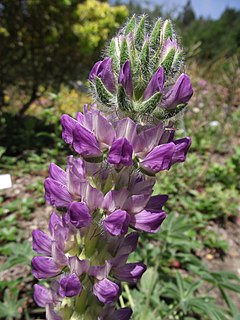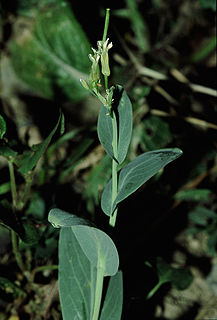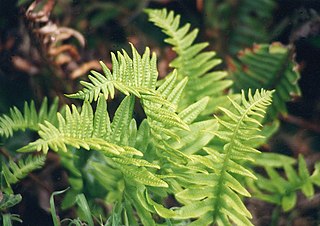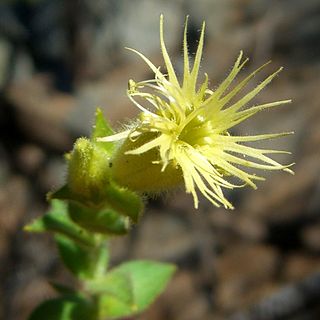
Sabal minor, commonly known as the dwarf palmetto, is a small species of palm. It is native to the deep southeastern and south-central United States and northeastern Mexico. It is naturally found in a diversity of habitats, including maritime forests, swamps, floodplains, and occasionally on drier sites. It is often found growing in calcareous marl soil. Sabal minor is one of the most frost and cold tolerant among North American palms.

Baptisia australis, commonly known as blue wild indigo or blue false indigo, is a flowering plant in the family Fabaceae (legumes). It is a perennial herb native to much of central and eastern North America and is particularly common in the Midwest, but it has also been introduced well beyond its natural range. Naturally it can be found growing wild at the borders of woods, along streams or in open meadows. It often has difficulty seeding itself in its native areas due to parasitic weevils that enter the seed pods, making the number of viable seeds very low. The plant has low toxicity levels for humans.

Lupinus microcarpus, the wide-bannered lupine or chick lupine, is a species of lupine native to western North America from southwestern British Columbia south through Oregon and California, including the Mojave Desert, and into Baja California. There is also a disjunct population in South America, with locations in central Chile and western Argentina.

Sarracenia minor, also known as the hooded pitcherplant, is a perennial, terrestrial, rhizomatous, herbaceous, carnivorous plant in the genus Sarracenia. Like all the Sarracenia, it is native to North America.

Gilia capitata is a species of flowering plant in the phlox family known by the common names blue-thimble-flower, bluehead gilia, blue field gilia, and globe gilia.

Saltugilia splendens, is a species of flowering plant in the phlox family known by the common names splendid woodland-gilia, Grinnell's gilia and splendid gilia.

Allium cratericola is a species of wild onion known by the common name Cascade onion. It is endemic to California, where is an uncommon member of the flora in several of the state's mountain ranges, including the northern and southern California Coast Ranges, the western Transverse Ranges, Klamath Mountains, and the Sierra Nevada foothills. Its range covers much of the state, from Riverside County to Siskiyou County.

Conringia orientalis is a species of flowering plant in the mustard family known by the common name hare's ear mustard. It is native to Eurasia but it is known elsewhere as an introduced species and sometimes a noxious weed. It is weedy in its native range and also in North America, where it is a widespread invasive species, especially in central Canada.
Gilia austrooccidentalis is a species of flowering plant in the phlox family known by the common name southwestern gilia. The scientific name is sometimes spelt Gilia austro-occidentalis. It is endemic to the Central Coast Ranges of California, where it grows in local hill and valley habitat.
Saltugilia caruifolia is a species of flowering plant in the phlox family known by the common names carawayleaf gilia and caraway-leaved woodland-gilia. It is native to the Peninsular Ranges of southern California and northern Baja California, where it grows in local habitat types such as chaparral. This herb produces a thin stem 12 centimeters to about a meter long. The leaves are up to 8 centimeters long at the base of the plant and divided into many finely subdivided lobes. The top of the stem branches into an inflorescence dotted with many glands. It produces flowers with lavender lobes dotted with darker purple near the bases.
Gilia diegensis is a species of flowering plant in the phlox family known by the common name coastal gilia.
Monardella australis is a species of flowering plant in the mint family, known by the common name southern monardella.
Pedicularis howellii is an uncommon species of flowering plant in the family Orobanchaceae known by the common name Howell's lousewort. It is endemic to the Siskiyou Mountains of the Klamath Range in southern Oregon and northern California, where it grows on the edges of coniferous forests. This is a perennial herb producing one or more stems up to 45 centimetres (18 in) tall from a long caudex. The leaves are up to 20 centimetres (8 in) long, lance-shaped, and divided into many toothed oval lobes; those higher on the stem may be unlobed. The basal leaves fall away early. The inflorescence is a small raceme of flowers occupying the top of the stem. Each white to light purple flower is up to one centimetre long and is sickle-shaped, with a curved beak-like upper lip and a three-lobed lower lip which may be tucked into the hairy mass of sepals. The plant is pollinated by bumblebees including Bombus mixtus. Between the flowers are hairy to woolly triangular bracts. The fruit is a capsule just under a centimeter long containing seeds with netted surfaces.

Polypodium californicum is a species of fern known by the common name California polypody.

Silene parishii is a species of flowering plant in the family Caryophyllaceae known by the common name Parish's catchfly. It is endemic to southern California, where it is known from several of the local mountain ranges, including the San Bernardino, San Gabriel, and San Jacinto Mountains. It grows in rocky, forested habitat, sometimes in the alpine climates of the higher peaks. It is a perennial herb growing from a woody, branching caudex and taproot, sending up several decumbent or erect stems 10 to 40 centimetres tall. The oppositely arranged leaves line the stems, the largest ones located at the middle of each stem. Leaves are lance-shaped to nearly oval and up to 6 centimetres long. They are thick and leathery, and sometimes glandular and sticky. Each flower is encapsulated in a tubular calyx of fused sepals which may be nearly 3 centimetres long. It is greenish with ten veins and a coating of glandular hairs. The five petals are yellowish in colour and each has about six long, fringelike lobes at the tip.
Saltugilia latimeri is an uncommon species of flowering plant in the phlox family known by the common name Latimer's woodland gilia. It is endemic to California, where it is known from several scattered occurrences in the western Mojave Desert and outlying areas to the north. It occurs in dry rocky and sandy desert canyons. It was first described as a species in 2001.

Linanthus pungens is a species of flowering plant in the phlox family known by the common names granite prickly-phlox and granite gilia. It is native to western North America from British Columbia to Baja California and east to Montana and New Mexico.

Aliciella caespitosa is a species of flowering plant in the phlox family known by the common names Rabbit Valley gilia and Wonderland Alice-flower. It is endemic to Utah, where it is known only from Wayne County.

Saltugilia is a genus of flowering plants in the phlox family, Polemoniaceae. They are known commonly as woodland gilias. There are four species. Two are endemic to California in the United States, and the distributions of the other two extend into Baja California in Mexico.

Tulipa sylvestris, the wild tulip or woodland tulip, is a Eurasian and North African species of wild tulip, a plant in the lily family. Its native range extends from Portugal and Morocco to western China, covering most of the Mediterranean and Black Sea Basins, and Central Asia. The species is also cultivated as an ornamental and naturalized in central and northern Europe as well as a few scattered locations in North America. It was first recorded as being naturalised in Britain in the late 17th century.














